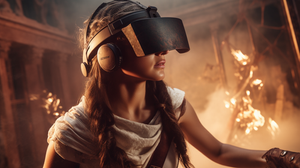In recent years, the advent of augmented reality (AR) has revolutionized various industries, including education. One area where AR has shown remarkable potential is in science education games. By incorporating AR technology, these games offer an immersive and interactive learning experience that goes beyond traditional methods. In this article, we will explore the integration of augmented reality in science education games and its significant impact on enhancing STEM learning.
1. Understanding Augmented Reality (AR):
Before delving into the integration of AR in science education games, it is crucial to understand the concept of AR itself. Augmented reality refers to a technology that overlays digital information, such as images, videos, and 3D models, onto the real world. It seamlessly blends the virtual and physical environments, allowing users to interact with and manipulate virtual objects in real-time.
2. The Benefits of Augmented Reality in Science Education Games:
Augmented reality brings a multitude of advantages to science education games, making them more engaging and impactful for learners. Some of the key benefits include:
a. Enhanced Visualization: AR enables students to visualize complex scientific concepts in a more interactive and intuitive manner. It allows them to see virtual models of atoms, planets, or even DNA structures, bringing abstract concepts to life.
b. Hands-On Learning: By integrating AR in science education games, students can actively participate and manipulate virtual objects. They can conduct virtual experiments, dissect virtual organisms, or even explore the inner workings of the human body, fostering a deeper understanding of scientific principles.
c. Real-World Context: AR allows science education games to provide a real-world context for learning. By augmenting virtual objects into the physical environment, students can see how scientific concepts apply to their surroundings, thus bridging the gap between theory and practical application.
d. Personalized Learning: Augmented reality empowers educators to customize the learning experience based on each student’s needs. Through AR-enabled games, teachers can adapt difficulty levels, provide instant feedback, and track individual progress, promoting personalized and adaptive learning.
3. Examples of Augmented Reality Integration in Science Education Games:
The integration of augmented reality in science education games has already sparked fascinating developments. Here are a few notable examples:
a. Anatomy AR: This app uses AR to allow students to explore the human body in an interactive way. By pointing their devices at a specific body part, students can see detailed 3D models, learn about its functions, and even zoom in for a closer look, revolutionizing the study of human anatomy.
b. Earth AR: Through Earth AR, students can explore the wonders of geology and geography. By simply pointing their devices at any location on Earth, they can visualize geological layers, tectonic plate movements, and even past climate changes, making learning about our planet’s history a captivating journey.
c. Chemistry Lab AR: This AR-powered game offers a virtual chemistry lab, providing a safe and immersive environment for students to experiment with various chemical elements and reactions. By engaging in practical chemistry experiments through AR, students can develop essential laboratory skills and reinforce their understanding of chemistry concepts.
4. Overcoming Challenges and Future Potential:
While augmented reality in science education games presents numerous advantages, there are also challenges to consider. The cost of implementing AR technology and ensuring equitable access for all students is one such challenge. Additionally, the need for robust hardware devices may require institutions to invest in the necessary equipment.
Looking ahead, however, the future potential of integrating AR in science education games is incredibly promising. As technology advances and becomes more affordable, AR has the potential to revolutionize the way we learn and teach science. Improved collaboration features, increased interactivity, and further personalization are just some of the advancements we can expect to see.
Conclusion:
Augmented reality’s integration into science education games has opened up a world of possibilities for STEM learning. The technology’s ability to enhance visualization, provide hands-on learning experiences, offer real-world context, and facilitate personalized learning is invaluable to both educators and students. As we continue to embrace AR’s potential, it is undoubtedly an exciting time for science education, as the boundaries of traditional learning are pushed, and new frontiers of knowledge are explored.



